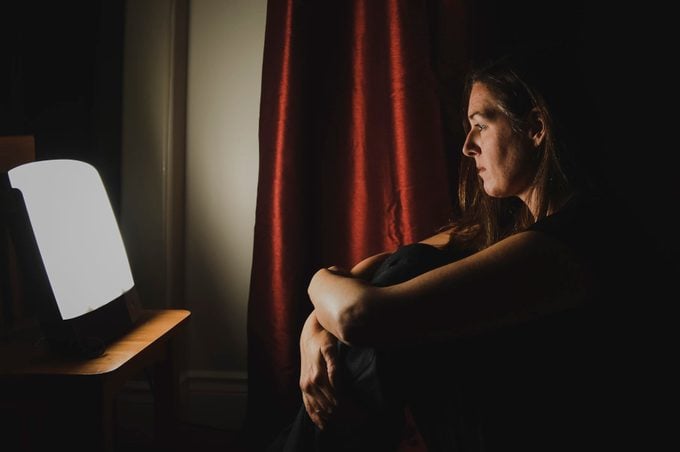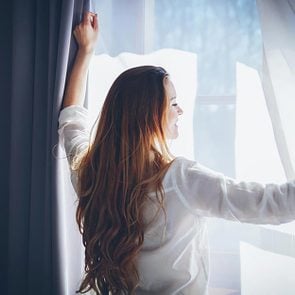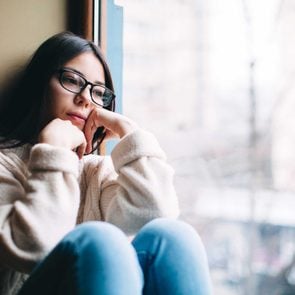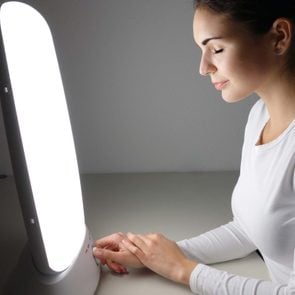What Is Light Therapy? How Light Can Heal a Variety of Health Problems
Updated: Mar. 16, 2022
Whether you’re dealing with depression, acne, pain, or a skin condition, you may be able to feel better or reduce your symptoms with light therapy.
On This Page
What is light therapy?
Pills, creams, and invasive treatments aren’t the only answer to health problems. Whether you’re dealing with depression or skin disorders, migraines or other chronic pain, sometimes you just need to turn to the light. Depending on the condition, there may be something along the colorful spectrum of light therapy to alleviate your symptoms and give you relief.
As anyone who’s ever used a prism or looked at a rainbow knows, white light isn’t really white at all—it’s all colors of the rainbow, from red to violet. Each color is determined by the wavelength of the light, and there are even some wavelengths that aren’t visible to the human eye.
Some wavelengths can be damaging to human health—like ultraviolet (UV) waves, which can harm your skin and eyes—while others may actually be good for your health.
For example, green light therapy—a type of LED, or light emitting diode therapy, that doesn’t contain UV rays—is thought to help migraine and other chronic pain. Blue light therapy can be prescribed for acne. Red light is thought to help rejuvenate skin by minimizing wrinkles, fine lines, and other signs of aging.
Dermatologists treat skin conditions like psoriasis, eczema, and rosacea with different types of light. And light without harmful UV rays can be used to help treat seasonal depression.
Here’s a look at the types of light therapy and what the science says about how they work.

Light therapy for depression
When winter sets in and the days get shorter, it can feel as if someone’s turned the lights out on your happiness. Just convincing yourself to go out, talk to your friends, or take care of yourself in ways that would benefit your well-being can be a challenge.
If this sounds like you, it’s possible you might find relief—and a new energy for the season—with light therapy for depression.
Light therapy involves the use of light, either from sunlight or an artificial UV light source, such as a light box or therapy lamp. (Here are the 10 best light therapy lamps on Amazon.)
Light therapy for seasonal affective disorder
Also known as light treatment, phototherapy, or heliotherapy, light therapy is often used in the treatment of seasonal affective disorder (SAD). If your mood and behavior change significantly with the change in seasons, you may have SAD. A type of depression, it most often strikes in the late fall or early winter, and then lifts again with the arrival of spring. It can also happen in the reverse pattern, with depression in the summertime.
You may suspect you have winter SAD if, in addition to depression symptoms—like low energy, loss of interest in activities, and feelings of hopelessness or worthlessness—you also begin to oversleep, overeat, gain weight, and avoid social situations. Experts believe that winter SAD is brought on, in part, by reduced exposure to natural light as the days grow shorter, which may affect mood-regulating neurotransmitters like serotonin.
“About one in 20 Americans get depressed in winter,” says Michael Terman, PhD, professor of psychiatry at Columbia University in New York City and president of the Center for Environmental Therapeutics. “Another three [in 20] feel lousy in winter but not at clinical severity. And many more feel symptoms associated with SAD, like overeating with significant weight gain—without any decline in mood.”
How light therapy treats SAD
During light therapy, you’re exposed to a bright light box daily for 30 to 45 minutes in the morning starting in the fall and continuing into the spring.
There is a wealth of research showing that people with SAD feel better with light therapy. In fact, this is the first-line treatment for SAD. That’s because light stimulates nerve fibers along the optic nerve (located in the back of your eye) and activates a particular part of your brain called the lateral habenula, which “directly elicits mood elevation,” says Terman.
Terman says that they’ve seen rapid results in patients.
“If the timing and dosing are correct from the start and do not require adjustment, we have seen relief from deep depression in just a couple of days, and most often within a week,” he says. That is far quicker than antidepressant medication, which can take weeks or months to show similar results.
Light therapy for other types of depression and disorders
Light therapy might also treat non-seasonal depression. Terman points to a randomized, placebo-controlled clinical trial, published in JAMA Psychiatry in 2016. The study compared light therapy for 30 minutes per day in the early morning plus a placebo pill; fluoxetine (Prozac), an SSRI antidepressant alone; a combination of the two; or a placebo in the treatment of major depressive disorder.
“Light therapy outperformed the drug by a mile,” says Terman. “The drug did no better than an inactive placebo. However, when the light was combined with the drug, the improvement in depression was greatest of all.”
There is also evidence that bright white light therapy can help treat bipolar depression, according to a randomized double-blind placebo-controlled trial, published in 2017 in The American Journal of Psychiatry. Researchers found that nearly 70 percent who were treated with bright white light for four to six weeks experienced remission in symptoms, a reality for just 22 percent of the placebo light group. The bright light group also had lower depression scores compared to the placebo.
In addition, light therapy is also tapped to treat circadian rhythm disorders. That’s when your sleep-wake cycle is out of sync with your environment. For instance, you might go to sleep at an extremely late hour or wake up at an unusually early time. And, as a result, your daily functioning is affected.
Circadian rhythm disorders are partially treated with light exposure in the morning or at night to shift your clock, notes Lawrence Jay Epstein, MD, clinical director of the division of sleep and circadian disorders at Brigham and Women’s Hospital in Boston.
“The most potent form of light is sunlight, but if you need to deliver light at times when the sun is not available, then you can use a light box,” he says.
How to shop for and use a light box or lamp
It’s possible to do light therapy at home, as long as you follow the rules for timing, dosing, and light box design, says Terman. There are so many products on the market, but not all will be effective. The Center for Environmental Therapeutics, which provides light box selection guidelines, suggests looking for the following: a high dosage (10,000 lux) that remains effective at a comfortable seating distance (so you don’t have to put your face extremely close to the device); transparency on product specifications; and a polycarbonate UV filter, to protect eyes and skin.
A miniature light box is unlikely to be effective. “These devices have not been clinically tested,” says Terman.
“Light therapy is not regulated by a medical society or federal standards,” he adds. So “unfortunately, ‘anything goes.’ ”
The Center for Environmental Therapeutics also recommends placing the box directly in front of you and making sure the light is coming from above eye level to limit glare. The center also advises reading or eating breakfast when using the light box, which helps you keep your eyes open enough to make treatment effective.
Risks and side effects of light therapy
The risks of bright light therapy include skin and eye damage. If you have preexisting medical conditions of your eyes and skin (such as diabetic retinopathy) or are taking certain photosensitizing medications, you should talk to your doctor before using light therapy.
In order to make sure that you’re doing light therapy correctly—with the right dose, at the right time—it’s best to talk to your physician first rather than trying to determine this for yourself. You also don’t want to stop medication you’re currently taking to treat depression. Ask your doctor about how light therapy might fit in with your current treatment plan.
Blue light therapy for acne
Sometimes topical creams aren’t enough to heal stubborn acne. Blue light therapy may be able to kill several types of common bacteria responsible for causing acne. The blue light wavelength also can slow down oil production in the sebaceous glands. Oil plugs the hair follicles, which can cause acne.
In one study published in the Journal of Drugs in Dermatology, 33 people with mild to moderate acne received blue light therapy treatment twice a day for eight weeks. They also used a cleanser before treatments and a serum each evening. More than 90 percent of participants reported improvements in their skin’s appearance, clarity, tone, texture, and smoothness after treatment.
Another study in the journal Drug Resistance Updates found that 77 percent of people with acne who had five weeks of blue light therapy treatment saw improvements in their skin.
Rarely is light therapy the only thing you’ll need to clear acne however, according to the American Academy of Dermatology (AAD). It usually works best along with a topical cream or some other treatment. You’ll usually need several applications to see results.
Side effects can include temporary redness and swelling, stinging and burning. Long-term pain, blistering, and scarring is rare, but possible.
Blue light therapy typically isn’t helpful for blackheads, whiteheads, acne cysts, or nodules, according to the AAD.
Red light therapy for skin issues
Red light therapy can be used on its own or in conjunction with blue light to treat acne, according to the AAD. It’s not as common, however, as blue light as a solo therapy for acne.
Red light is believed to act on skin cells called fibroblasts, which help produce collagen. Collagen is the supportive protein structure in the skin that plays a role in aging.
Because of this connection, red light therapy is sometimes used in an attempt to rejuvenate skin. It can target wrinkles, fine lines, roughness, and other signs of aging.
In a study published in the Journal of Photochemistry and Photobiology B: Biology, people with facial wrinkles received varying wavelengths of red light therapy or no treatment twice a week for four weeks. Those who received red light therapy had improved measures of elasticity and fewer visible wrinkles.
In another study, published in Photomedicine and Laser Surgery, people receiving red light therapy had visible changes in wrinkles and skin roughness.
Red light therapy can also cause temporary redness, swelling, and burning. Long-term pain and scarring is also possible, but rare.
Green light therapy for migraine and other pain
Green light therapy shows some promise for easing the pain of migraines and some chronic conditions.
In a small study published in Cephalgia in 2020, researchers recruited 29 patients with chronic or episodic migraines and exposed them to white light for two hours daily for 10 weeks as a control. After a two-week break, they exposed them to two hours of green light daily for 10 weeks.
During green light therapy, episodic migraines decreased from 7.9 to 2.4 headaches monthly and chronic migraines from 22.3 to 9.4 headache days each month.
But it’s not just headaches. In another study, published in Pain Medicine in 2020, 21 adults with fibromyalgia were exposed to white light daily for 10 weeks, then exposed to green light therapy. Fibromyalgia is a condition characterized by overall pain, fatigue, and sleep issues. During green light treatment, patients reported a significant reduction in pain intensity.
Studies in rats found that exposing the animals to green light seemed to decrease their levels of pain, according to a study in a 2017 issue of Pain. Researchers discovered that enkephalins—a molecule that acts as a natural pain reliever in the body—increased by three times in the rats when exposed to green light.
Light therapy for rosacea
Rosacea is an inflammatory skin condition characterized by facial redness. Doctors sometimes suggest light therapy for rosacea to help ease some of the symptoms. Targeted light therapy decreases inflammation on a cellular level by promoting healing.
According to the AAD, light therapy may be an option, especially if you have visible blood vessels. Most patients see a 50 percent to 75 percent decrease in visible blood vessels after one to three treatments. Results typically last three to five years.
There’s typically redness or a rash immediately after treatment that usually fades within two weeks. You may also have pain, itching, or tightness during treatment.
In a study, published in 2020 in the journal Lasers in Surgery and Medicine, people with rosacea who had facial redness were given a form of light therapy and/or a prescription cream. Those who were treated with both the light therapy and the cream saw the greatest improvement in their redness.
Light therapy may not be as effective if your rosacea symptoms are primarily pimples or pustules (papulopustular rosacea), thickening of the skin (phymatous rosacea), or a bulbous growth around the nose (rhinophyma).
There are different types of laser therapy for rosacea including pulsed dye lasers and intense pulsed light (IPL) therapy, which use several colors of light at once.
UV light for psoriasis and eczema
Different wavelengths of UV light may be a treatment for eczema and psoriasis. Eczema is an umbrella term for a group of skin conditions noted for itchiness, redness, and rashes. Psoriasis is a common skin condition that causes scales and itchy, dry patches.
Phototherapy uses different wavelengths of UV light targeted to treat itchiness and redness and other symptoms. Because UV rays can be harmful to skin, it’s important that you follow a short-term treatment plan under the care of a health care professional.
Phototherapy and eczema
For eczema, dermatologists most commonly will use narrowband ultraviolet B (NB-UVB) light, according to the National Eczema Association. Other options may include ultraviolet A (UVA) light.
Researchers aren’t sure exactly how UV therapy works but it reduces inflammation in the skin, having an impact on the immune system, reports the National Eczema Society. To have an effect, it takes several weeks of treatments at least 2-3 times per week to show an improvement. Once your skin is nearly clear and/or itching has stopped, your dermatologist will reduce the frequency of treatments gradually.
Phototherapy is used with adults or children who have moderate to severe eczema that isn’t responding to standard treatments like steroids and topical creams. Side effects may include temporary redness and dryness. Long-term use can result in accelerated aging and an increased risk of skin cancer and cataracts.
Phototherapy and psoriasis
UV light therapy can be prescribed by dermatologists for psoriasis to slow skin cell growth, reduce inflammation, ease itching, and suppress immune system activity, according to the AAD. The excimer laser, which offers narrowband UVB light, has been approved by the Food and Drug Administration (FDA) for treating chronic, localized psoriasis plaques, reports the National Psoriasis Foundation. It may be safely used on many parts of the body including elbows, knees, scalp, ears, armpits, and the groin.
Phototherapy is typically given 2-3 times a week for several weeks in order to be effective. UV therapy is most often prescribed for mild to moderate psoriasis and has been found to be particularly effective for scalp psoriasis.
It can cause short-term redness, burning, and itching. Long-term use can lead to aging, cancer, and freckles.
Personal stories about light therapy
Here are stories of people who used light therapy to treat a variety of conditions:
- I Used a Light Therapy Lamp for Seasonal Depression
- I’ve Had Rosacea for 15 Years and These Are the Treatments that Worked



